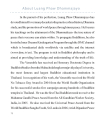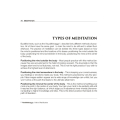Buddhist practice : ค้นหาหนังสือธรรมะ หน้า 3 / 17
หน้าหนังสือทั้งหมด

7
Wisdom of Luang Phaw: Sayings on Meditation and Life
Preface
This is a collection of some of the sayings given by Luang Phaw
the period 1988-2000. It must be said that this book is one of the
first examples of his work to appear in English. The book's c
This book features a compilation of sayings by Luang Phaw from 1988-2000, marking one of the first appearances of his teachings in English. Initially published in Thai as 'Kong Kwan' in 2000, the sele

127
The Practice of Ānāpānasmṛti: Breath Meditation in Early Buddhism
describing the practice of the four smrtyṣhānas associated with the breath (ānāpānasmṛti), and resulting the attainment of the three vimoksamukhās.42
An Shigao’s translation of the Ānāpānasmṛti Sūtra
This text delves into the practice of Ānāpānasmṛti, a significant Buddhist meditation focused on breath. It highlights An Shigao’s translation of the Ānāpānasmṛti Sūtra and its influence on later monk

185
Survival of Buddhism and the Dhammakaya Temple
…akyara Meditation, he rediscovered the technique of meditation which was the original mainstream of Buddhist Practice, knowledge which had disappeared five-hundred years after the Lord Buddha passed to Nibbana.
The W…
The survival of Buddhism in Thailand is under threat due to abandoned temples and corrupt practices. The Dhammakaya Temple, however, stands resilient, guided by Buddhist principles imparted by its fou

139
Buddhist Texts and Historical Studies
The SAT Daizōkyō Text Database Committee. “出三藏記集 (No. 2145 (僧祐提)) in Vol. 55.” Taishō Shinshū Daizōkyō (大正新修大藏經), March 17, 1998. http://21dzk.l.u-tokyo.ac.jp/SAT/ddb-sat2.php?mode=detail&useid=2145,_
This collection includes significant Buddhist texts and studies, such as the Mahāyāna Buddhism foundations by Paul Williams and insights into early Chinese Buddhism by Erik Zürcher. Scholarly works di

569
Academic Contributions to Buddhist Studies
University of Washington.
Lévi, Sylvain. 1932. Mahākarmavibhanga (La Grande Classification des Actes) et Karnavibhangapadéša (Discussion sur le Mahā Karmavibhānga). Paris: Librairie Ernest Leroux.
Luo
This text references several significant academic contributions to Buddhist studies. Sylvain Lévi's work on Mahākarmavibhanga highlights the classification of deeds in Buddhist philosophy. Luo and Hon

571
Ancient Buddhist Manuscripts: Insights from Gandhara
Ruegg, D. Seyfort. 1967. On a Yoga Treatise in Sanskrit from Özvil.
Journal of the American Oriental Society 87 (2):157-165.
Saamblog. Gandhara Buddha Photos: Ancient Gandhara Buddhism 2009.
Available
This text provides an overview of various scholarly works focusing on ancient Buddhist manuscripts from Gandhara. Researchers like Richard Salomon and others have contributed to understanding these te

76
Luang Phaw Dhammajayo: A Beacon of Peace and Buddhism
About Luang Phaw Dhammajayo
In the pursuit of his perfection, Luang Phaw Dhammajayo has
devoted himselfovermany decadestothepracticeofmeditation, Dhamma
study, and the promotion of world peace through
Luang Phaw Dhammajayo has spent decades dedicated to meditation and Dhamma study, promoting world peace through inner peace. His teachings focus on attaining the Dhammakaya, the true nature of peace a

16
Launch of the Journal of the Dhammachai International Research Institute
Introduction
This collection of articles marks the launch of the Journal of the Dhammachai International Research Institute (JDIRI). The articles presented here indicate some of the perspectives on B
This collection of articles marks the launch of the JDIRI, showcasing perspectives on Early Buddhism and meditation studies. The journal aims to publish research on ancient manuscripts and esoteric pr

32
Dhamma-kāya in the Pali Canon
Dhamma-kāya in the Pali Canon¹
Chanida Jantrasrisalai
I. Why ‘Dhamma-kāya’ in the ‘Pali Canon’?
The term dhamma-kāya/dharmakāya appears in Buddhist literature of different schools. Previous scholars
The study investigates the term dhamma-kāya as presented in the Pali Canon, aiming to provide a comprehensive analysis that has been overlooked in previous studies. While many references have been mad

34
Understanding Dhammakāya in Early Buddhist Thought
II. The Different Approach
A fairly established academic understanding has settled regarding the term dhammakāya in the Pali canon, that it was used merely in the sense of the ‘Buddha’s teachings.’ In
The term 'dhammakāya' in the Pali canon is understood as representing the Buddha's teachings. It is established through several canonical passages that equate the Buddha with dhamma. Notable reference

121
The Influence of An Shigao on Mindfulness Breathing Meditation in Eastern Han China
In this paper I explore the connections between An Shigao and the introduction of the Indian Buddhist meditation technique of mindfulness breathing meditation, or ānāpānasmṛti, into Eastern Han China.
… and Thai Theravada Buddhism. This synthesis of ideas illustrates the assimilation and evolution of Buddhist practices in early medieval China. For more details, visit dmc.tv.

156
A ‘New’ Early Chinese Buddhist Commentary
Zacchetti, Stefano. 2008 "A ‘New’ Early Chinese Buddhist Commentary: The Nature of the Da Anban Shouyi Jing (T 602) Reconsidered." Journal of the International Association of Buddhist Studies 31: 421-
This research article by Stefano Zacchetti delves into the nature of the Da Anban Shouyi Jing (T 602), reconsidering its significance in early Chinese Buddhist commentary. The study provides insights

9
Buddhist Unity and Harmony: Insights from Most Ven. Dhammapriya Mahathero
Digest from speech of Most Ven. Dhammapriya Mahathero Abbot, Mahananda Sangharaj Vihara
Vice President of the Supreme Sangha Council of Bangladesh
Founder of Dhamapriya Buddhist Welfare Mission, Kolka
In a profound address, Most Ven. Dhammapriya Mahathero emphasizes the interconnectedness of all beings, portraying them as part of one family, deriving from shared karmic categories. He urges the prop

63
Charumati Buddha Vihar and Buddhist Mission in Nepal
Charumati Buddha Vihar and resident of Charumati Buddhist mission Nepal / วัด จารุมาติวิหาร ประเทศเนปาล
๒๖. โโล่งวัดและใบประกาศเกียรติคุณ จาก Prof. Dr. Mitomo Kenyo / ค.ศ. มิโดเมะ เกนโญ พระมหาเกระระด
Charumati Buddha Vihar in Nepal is notable for its contributions to Buddhism and its recognition with various honors from esteemed Buddhist figures worldwide. This includes accolades from Prof. Dr. Mi

33
Exploring Buddhist Texts and Influence
Bernhard, Franz.
1970 "Gåndhārī and the Buddhist Mission in Central Asia." Ánjali: Papers on Indology and Buddhism: A Felicitation Volume Presented to Oliver Hector de Alwis Wijesekera on His Sixtieth
This collection of works explores the significant contributions to Buddhist scholarship, including analyses of the Gåndhārī texts, the investigation of the Därșanatika, and the characteristics of the

28
Understanding the Root Causes of Life's Problems through Buddhism
Summary
Concepts - The root causes of life's problems include economic problems, conflicts, and defilements
- The Lord Buddha's Teachings aim to correct the root causes of life's problems
- Buddhism c
This text discusses the root causes of life's problems, including economic issues, conflicts, and mental defilements, proposing that the Teachings of the Lord Buddha offer comprehensive solutions. By

178
Practicing Austerity in Buddhism
"In order to differentiate between need and want, our
ancestors trained themselves by practicing austerity on every
Buddhist Holy Day. Many teaching monks say that if a person
wants to experience such
การฝึกอัสเตรีตี้ช่วยให้เราแยกแยะความต้องการและสิ่งที่ต้องการได้ชัดเจน โดยเริ่มจากการใช้ชีวิตในวัดและสวมเสื้อผ้าขาวเพื่อความมีสติและระมัดระวัง การปฏิบัติดังกล่าวนำมาซึ่งความสงบทั้งทางกายและจิตใจ และเมื

82
Types of Meditation
78 MEDITATION
TYPES OF MEDITATION
Buddhist texts, such as the Visuddhimagga¹, describe forty different methods of practice. All of them have the same goal: to train the mind to be still and to attain
Buddhist texts, like the Visuddhimagga, outline 40 meditation methods with the same goal of mastering the mind to achieve Buddhahood. Meditation can be categorized into three types: positioning the mi

185
The Survival of Dhammakaya Temple Amidst Abandonment
…makaya Meditation, he rediscovered the technique of meditation which was the
original mainstream of Buddhist Practice, knowledge which had disappeared five-hundred years after
the Lord Buddha passed to Nibbana.
The Wa…
This text reflects on the future of Buddhism in Thailand, especially regarding the increasing number of abandoned temples. It emphasizes the importance of the Dhammakaya Temple and its ability to with

181
Understanding External and Internal Fools in Buddhism
1) External Fools include non-Buddhists. They are determined to demolish Buddhism, whether they are of other religious affiliations or not. They typically try to cast aspersions upon Buddhist monks. W
In Buddhism, External Fools are non-Buddhists who seek to distort and undermine Buddhist teachings, casting aspersions on monks and creating confusion. Internal Fools, on the other hand, are Buddhists
